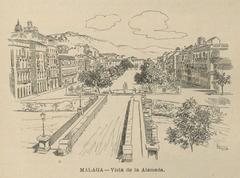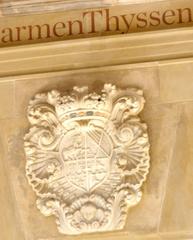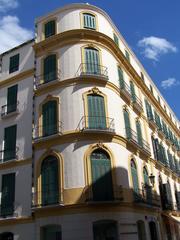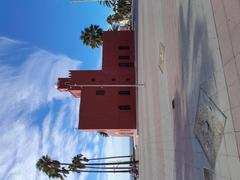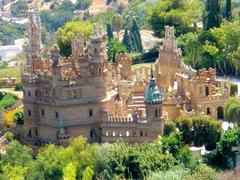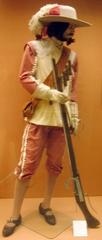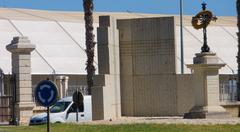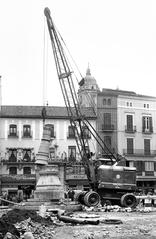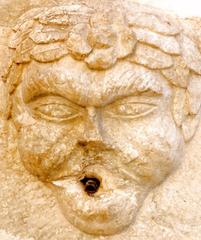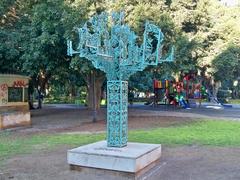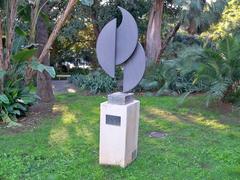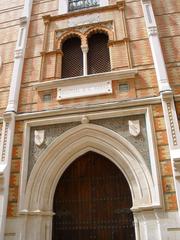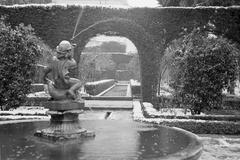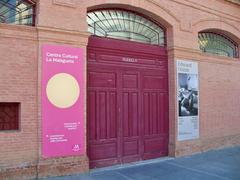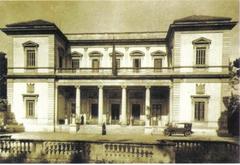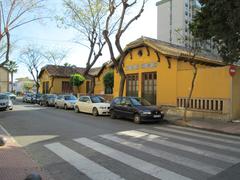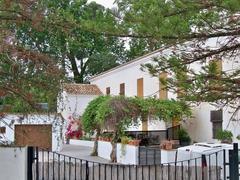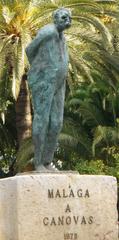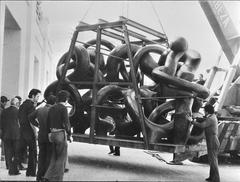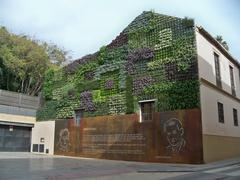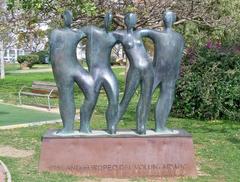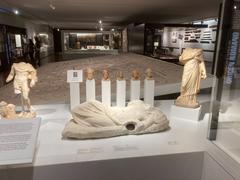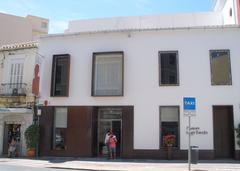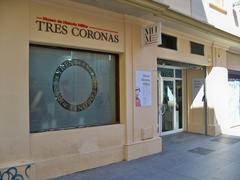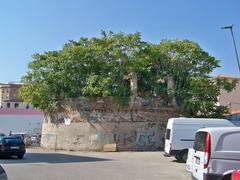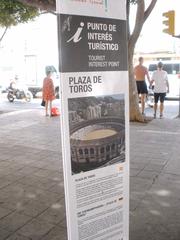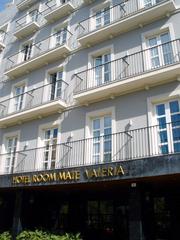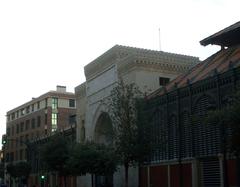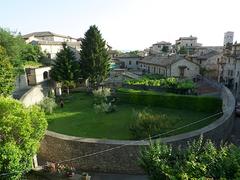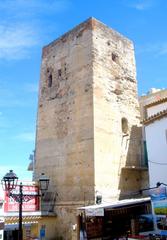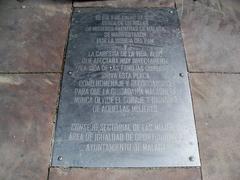Monument to the Skewer Maker in Málaga: Visiting Hours, Tickets, and Málaga Historical Sites Guide
Date: 14/06/2025
Introduction: A Tribute to Málaga’s Culinary Heritage
Málaga, a vibrant city on Spain’s southern coast, is internationally celebrated for its sun-soaked beaches, rich history, and lively gastronomy. At the heart of its culinary tradition lies the espeto—fresh sardines skewered on cane sticks and grilled over open fires along the Mediterranean shoreline. The Monument to the Skewer Maker (Monumento al Espetero) stands as a powerful homage to the espeteros, the artisans who have preserved and elevated this tradition for generations. Located on the Paseo Marítimo Antonio Machado near Playa de la Misericordia, this monument is a cultural landmark that connects visitors to Málaga’s coastal identity and communal spirit (Fuerte Hoteles; The Valfers).
This comprehensive guide explores the origins and evolution of the espeto tradition, provides essential information for visiting the monument, highlights the surrounding historical and cultural attractions, and offers expert tips for experiencing authentic Málaga.
Table of Contents
- Origins and Evolution of the Espeto Tradition
- The Espetero: Master of the Grill
- Cultural and Social Significance
- Monument to the Skewer Maker: Description and Location
- Espeto Experience: Where and How to Enjoy
- Preservation, Events, and Recognition
- Nearby Attractions and Historical Sites
- Frequently Asked Questions (FAQs)
- Summary and Visitor Tips
- Sources and Further Reading
Origins and Evolution of the Espeto Tradition
The espeto tradition—skewering and grilling sardines over open wood fires on the beach—has deep roots in Málaga’s maritime history. While its precise origins are debated, historians trace its practice back to at least the late 19th century, supported by artistic depictions such as Horacio Lengo’s La Moraga (1879), which showcases communal fish grilling on Málaga’s shores (Fuerte Hoteles). Some sources suggest even earlier roots, possibly dating to the Phoenician settlers of Malaca over 2,500 years ago (Wanderlust Chloe).
The modern espeto culture solidified in the fishing neighborhoods of El Palo and Pedregalejo, where returning fishermen would grill their fresh catch on bamboo or reed sticks, using sand-filled boats as makeshift barbecues (Spanish Sabores). The tradition was famously recognized when King Alfonso XII tasted espetos during his 1885 visit, elevating the dish to regional celebrity.
The Espetero: Master of the Grill
An espetero is more than a grill master; he is the guardian of a living tradition. The process involves skillfully skewering sardines—ideally fatty and fresh—over natural wood fires, often built in upturned fishing boats filled with sand. Seasoned simply with sea salt, the sardines are cooked until their skin is crisp and smoky, yet the flesh remains tender (Spain Food Sherpas). The craft is often passed down through generations, with many espeteros participating in festivals and competitions to showcase their expertise (Visit Costa del Sol).
Cultural and Social Significance
Espetos are more than a dish; they are a symbol of Málaga’s communal ethos. Enjoyed best in the company of friends and family at beachside chiringuitos, espetos represent the unity of sea, tradition, and celebration. The tradition is so revered that local organizations have campaigned for UNESCO Intangible Cultural Heritage status, highlighting its role in Málaga’s identity (Fuerte Hoteles).
Monument to the Skewer Maker: Description and Location
Physical Description
The Monumento al Espetero is a striking bronze sculpture, approximately two meters tall, mounted on a low stone pedestal. It depicts an espetero in the act of grilling sardines over a fire, capturing both the concentration and pride of the artisan. The lifelike details—down to the folds of his clothing and the flames licking the skewers—invite visitors to connect with Málaga’s culinary heritage (The Valfers).
Exact Location and Accessibility
The monument is situated on the Paseo Marítimo Antonio Machado, near the intersection with Calle Pacífico, adjacent to Playa de la Misericordia—one of Málaga’s most popular urban beaches (The Valfers; guiademalaga.net). The promenade is flat and wheelchair accessible, with plenty of nearby parking and public transport options.
GPS Coordinates: 36.7031° N, 4.4262° W
Visiting Hours and Tickets
- Hours: The monument is an outdoor public artwork accessible 24/7, all year round.
- Tickets: Admission is free; no tickets are required (guiademalaga.net).
How to Get There
- By Bus: City buses (lines 3, 7, and 40) stop nearby.
- By Car: Street parking available, though limited during peak hours.
- By Bike/Foot: The seafront promenade is ideal for walking or cycling (Spain.info).
Espeto Experience: Where and How to Enjoy
Best Places to Eat Espetos
The best way to experience espetos is at traditional chiringuitos along Málaga’s coast:
- Playa de la Misericordia: Numerous beach bars line the promenade near the monument.
- El Palo & Pedregalejo: Historic fishing districts famed for authentic espeto culture (Spanish Sabores).
- Recommended Chiringuitos: El Zagal and El Boquerón in El Palo; Avante Claro in La Cala (Spain Food Sherpas).
Best Time to Visit
Espetos are at their tastiest from May to August, when sardines are fattest and most flavorful. Most chiringuitos serve espetos year-round, typically from late morning until late evening (freetoursandalucia.com).
Preservation, Events, and Recognition
Málaga’s espeto tradition is celebrated annually during the Día del Espeto (usually in June), featuring live cooking demonstrations, tastings, and contests honoring the city’s best espeteros (guiademalaga.net). The espeto’s cultural value has inspired efforts for UNESCO heritage recognition, and ongoing community events and educational programs help sustain this cherished craft.
Nearby Attractions and Historical Sites
Enhance your visit by exploring Málaga’s cultural landmarks within easy reach of the monument:
- Chimenea de los Guindos: A historic industrial chimney.
- Centro Cultural La Térmica: Modern cultural center with exhibitions.
- Parque del Oeste: Urban park with sculptures and recreation.
- Museo Automovilístico y de la Moda: Unique blend of vintage cars and fashion.
- Colección del Museo Ruso: Rotating exhibitions from the Russian Museum (guiademalaga.net).
Other nearby historical sites include the Alcazaba Fortress, Roman Theatre, and Málaga Cathedral—easily accessible from the coastal district.
Frequently Asked Questions (FAQs)
Q: Where is the Monument to the Skewer Maker located?
A: On Paseo Marítimo Antonio Machado, near Playa de la Misericordia, Málaga.
Q: What are the visiting hours?
A: The monument is outdoors and accessible 24/7, year-round.
Q: Is there an admission fee?
A: No, visiting the monument is free.
Q: Is the site wheelchair accessible?
A: Yes, the promenade and monument area are flat and suitable for wheelchairs and strollers.
Q: When is the best time to visit for authentic espeto?
A: Early evening during the warmer months, especially from May to August.
Q: Can I enjoy espeto nearby?
A: Yes, many chiringuitos along the promenade and in El Palo and Pedregalejo serve freshly grilled espetos.
Summary and Visitor Tips
The Monument to the Skewer Maker is not just a sculpture—it’s a living tribute to Málaga’s enduring culinary tradition and the men and women who keep it alive. This accessible, free attraction offers an educational and sensory gateway into local culture. Pair your visit with a meal at a nearby chiringuito, explore historical sites, and, if possible, plan to attend a local espeto festival for the full Málaga experience.
Tips:
- Visit at sunset for beautiful photo opportunities.
- Respect local customs and compliment the espeteros on their skill.
- Use the Audiala app for interactive maps, event updates, and insider tips.
Sources and Further Reading
- Fuerte Hoteles
- The Valfers
- Free Tours Andalucía
- Guia de Málaga
- Spanish Sabores
- Visit Costa del Sol
- Spain Food Sherpas
- Wanderlust Chloe
Images Recommended:
- Photo of the Monument to the Skewer Maker in Málaga (alt: “Bronze sculpture of an espetero on Paseo Marítimo Antonio Machado”)
- Espetos grilling at a beach chiringuito (alt: “Espetos grilling on the beach in Málaga”)
- Map of Málaga highlighting espeto locations and historical sites
For more travel inspiration and practical tips, download the Audiala app and follow us on social media.
